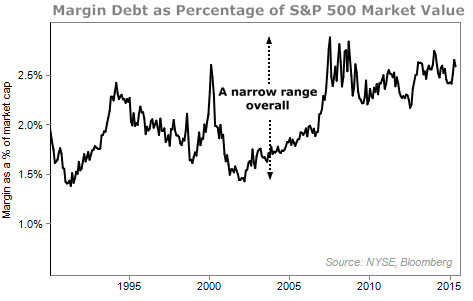| Home | About Us | Resources | Archive | Free Reports | Market Window |
Don't Let This Nonsense Number Fool YouBy
Wednesday, August 5, 2015
Some people just want to see the worst in a stock market...
They like to take every fact or statistic they can find and twist it into an omen of doom.
We don't work that way. In my Retirement Trader newsletter, we look at the facts, talk about them, and draw simple conclusions about what's possible.
As longtime subscribers know, we've been bullish on America, the U.S. economy, and the market for five years running. And we've largely been right. We've talked about a slow grind higher and higher.
The current nail biting over "margin debt" is just the latest example of what I'm talking about...
Buying "on margin" means to buy with money borrowed from your broker. The following chart shows that the amount of money that stock investors have borrowed has recently climbed to almost $500 billion.
 To a bear, that looks like the market is getting "frothy"... when people get so excited about stocks that they start borrowing more and more money to buy them. Pretty soon, that frothiness causes a crash. And in the chart, you can see that margin debt and stock prices fell together during the bear markets of 2000 and 2007-2008.
Guess what? Margin debt is a nonsense number. And that chart contains all the information you need to realize it.
It's not investor euphoria or excessive risk-taking that's driving margin borrowing up... It's just the market.
After all, if investors borrow a consistent amount of their holdings to boost their returns, then that amount will rise as the value of their holdings rise.
And margin debt as a percentage of total market cap has remained consistent, floating around the 2% level.
 It is a touch on the high side compared with the bearish bottom of 2002... but there have been no sharp moves or spikes to suggest a bubble in the making. Make no mistake about it, debt does cause volatility. But the level of debt here just isn't that high or troublesome.
We remain confident in the markets as a whole. And we're still bullish on the stock market and content with the economy.
Here's to our health, wealth, and a great retirement,
Dr. David Eifrig
Further Reading:
As Doc explained in today's DailyWealth, he remains confident in the markets. But at some point, we'll face another crisis. "It's inevitable," he says. In this recent essay, he shows you how you can gain a huge advantage when it arrives.
"Most people who call themselves 'investors' really aren't," Doc says. "People buy high and sell low... Ultimately, it's a lot of stress and research for an uncertain payoff." But as Doc explains in last month's essay, there's an easier way. Learn more here: This Is Your Cure for Stock Market Volatility.
Market NotesAN IMPORTANT LESSON ON BUYING "EXCITING" Today's chart is further proof that massively popular investments can turn ugly in an instant...
Last week, we took a look at online retailer Amazon, which has been on a tear of late. But things haven't looked as rosy for social-media website Twitter.
Twitter allows its users to broadcast short messages and follow the latest news and information on celebrities, athletes, and any other person or organization with an account. The free service boasts around 200 million active users. For a while, the Internet sensation was one of the hottest, most exciting stocks in the market. But as our colleague Doc Eifrig says, the word "exciting" often comes right before big investment losses.
Investors lined up to buy Twitter shares... and now they are paying for it. Shares of the social-networking giant recently fell to their lowest point since the company went public in November 2013... and have plummeted more than 40% in just the last four months alone. It's another example of how buying popular, expensive investments with the rest of the herd often leads to disappointment.
 |
Recent Articles
|



